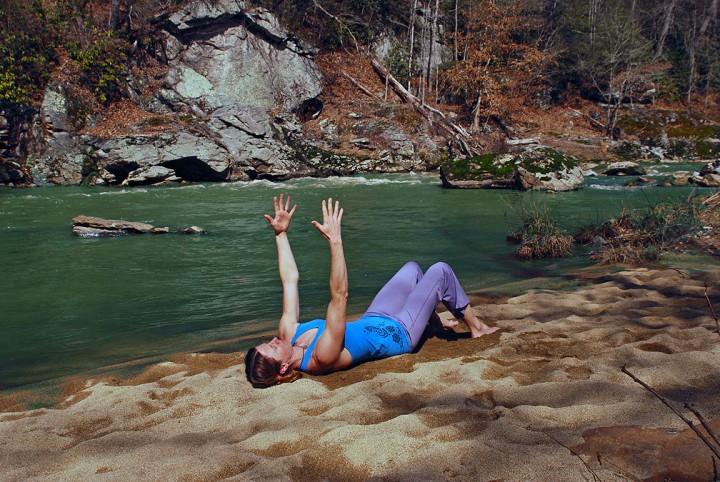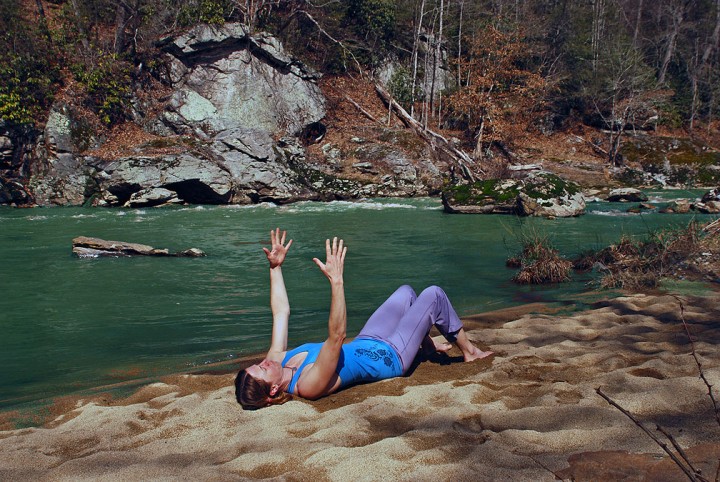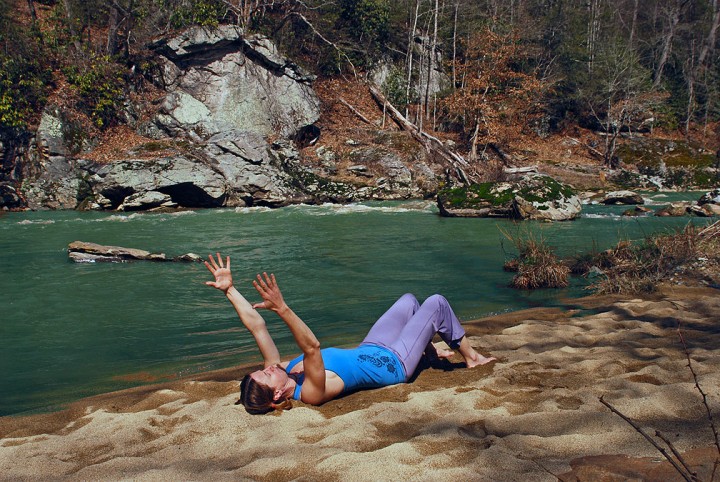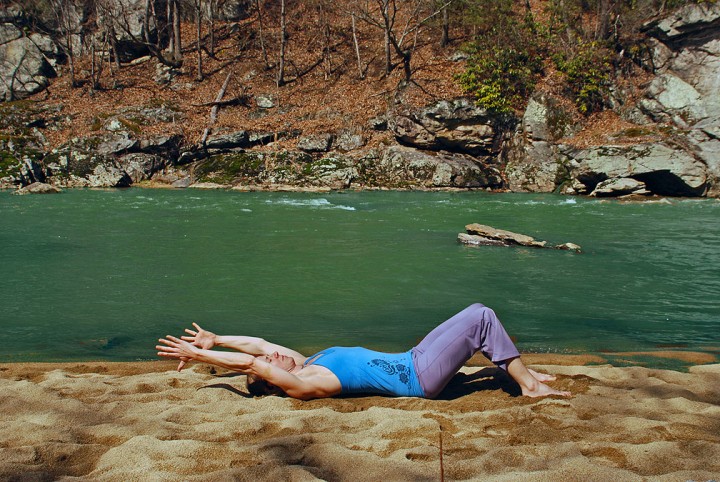Yoga for Boaters' Back Pain
Boaters are known for having trouble maintaining two things: relationships and shoulders. I’ll spare you any relationship advice. But for your shoulders, I have plenty!
As a yoga teacher and boater, I get lots of questions about dealing with shoulder pain and injuries. People often ask for one stretch or exercise they can use to help them heal. I’ll tell you one, but first we need to discuss some stretching basics and talk about what yoga is and isn’t.
First of all, yoga is not stretching. Yoga, as it is known today, is a system of healing which focuses on the mind, body and breathing. Practicing yoga can help you heighten your overall awareness and improve your body’s alignment, ease, comfort and strength. Yoga will only work for you if you do it with mindfulness. Without mindfulness, it is not yoga, and it can actually exacerbate existing problems.
In the yoga system I teach, we start with the body—so we begin with yoga poses. The purpose of doing yoga poses isn’t to learn to contort yourself, but to learn healthy movement and range of motion for your body. You may experience some stretching while performing the poses, but stretching isn’t the goal. The goal is to gain a healthy range of motion for boating.
Take a few minutes now to think about paddling. Envision yourself in your boat. From the moment you sit down, taking your thighs into external rotation, you’re stretching. Now picture yourself paddling hard through a rapid, reaching for a forward stroke or a draw stroke, setting up for a roll, or doing a flat spin. All of these actions require your muscles to stretch. But the most important issue isn’t stretching; it’s range of motion, of which muscle flexibility is a critical component. When you think of it this way, you’ll feel less inclined to push your body into a stretch and more inclined to move your body in a more holistic way.
Once you’ve gained a healthy range of motion, you can begin doing poses that build strength. Just don’t skip that all-important first step; putting weight on a joint that is not in healthy alignment can cause further damage and instability. You’ll know when your range of motion and alignment are good when you’re not experiencing pain. If you feel pain during a pose, back out until you return to a pain-free zone. Your body is your guide, and when you listen to it, you’ll be amazed with the results! As your alignment improves through your range-of-motion poses, you can transition to weight-bearing poses to help strengthen your chest and upper back muscles, including your rotator cuff muscles.
Finally, when you’re performing yoga postures, always pay attention to your breathing. There are many breathing techniques in yoga that have various uses, but breathing doesn’t have to be complicated; the most important thing to remember is just to breathe. As you move, make sure you’re not holding your breath. Let your body relax and breathe fully. Use your breath to help check your body for tension. Shallow breathing, a sign of tension, indicates that you’re not in a “good place” in a pose. When this happens, back out of the pose, then return to it only as far as you can while still breathing freely and naturally.
Proper breathing will not only help you physically, but it will help you stay “in the zone” mentally too. If you’re holding your breath, chances are you’re thinking too much or trying too hard. Learn to let go of your thinking mind and just follow your breath.
To summarize, here are the three key components of a yoga routine for your shoulders:
- Maintain awareness of your movements and free, natural breathing
- Perform poses to improve your range of motion and alignment
- Perform strengthening exercises
If I had to pick one area of the shoulders to focus on for boaters, it would be the shoulder blades. Your shoulders are only as mobile and stable as your shoulder blades. When they become stiff or immobile, your shoulder sockets compensate by becoming hyper mobile. So when I create a yoga routine, I like to focus on gaining strength and mobility in the shoulder blades.
Exercise
Here is the best yoga exercise that I’ve found for alleviating and preventing pain in boaters’ shoulders. It’s great to do every morning, before yoga or weightlifting, before rotator cuff exercises, before and after boating, or anytime you need to warm up and align your shoulders.
Lie down on your back with your arms at your sides. Keep your knees bent and your feet on the floor. Take some deep breaths and relax your whole body. Feel your breath as it broadens your collarbones. Take a few moments to completely relax your shoulders. Feel your shoulder blades on the floor as you breathe.
If you can do so without pain, pinching or popping, straighten your arms out in front of you. Reach toward the sky with your arms shoulder-distance apart and your palms facing one another.
Relax your arm bones into your shoulder sockets so that the backs of your shoulders relax toward the floor. Breathe fully.

As you exhale, initiating the movement by spreading your shoulder blades apart, reach toward the sky, lifting your shoulders slightly off the ground.

Inhale and release your shoulders back down to the floor.
Now continue the exercise, moving with your breath about 5-10 times. Lead the motion with your shoulder blades by spreading the shoulder blades as you reach and relaxing them together again as you come back down. If you feel any pain, decrease your movements until the pain recedes; do not reach your arm bones out of the shoulder sockets, and do not thrust the rib cage.
When you’ve finished, return to a neutral position. Relax your arm bones into your shoulder sockets so that the backs of your shoulders settle toward the floor and your shoulder blades relax.

Next, move your arms, in tiny increments, up and overhead. If you notice any clicking, popping, pain or weirdness, start over. Move until you come to the point just before the clicking, popping, pain or weirdness.

Only move within a pain-free and noise-free range of motion.
Keep the heads of your arm bones seated in the shoulder sockets and don’t let your rib cage thrust upward.
If you can bring your arms all the way overhead, stop when they are lined up with your ears. Do not rest them on the floor.

Take about five full breaths. Release the tension from your body. Relax your face.
Slowly bring the arms back up, following the same rules—stop just before any pain, clicking, popping or weirdness, until your arms return to your sides. If you can’t perform the exercise without popping, etc., bend your elbows.
Rest and take some deep breaths.
Perform the exercises again with your palms facing away from your face, as if you were holding a paddle.
When you can perform these movements with ease, then you are ready for some weight-bearing exercises—or a day of paddling!
May your shoulders always be strong and free, and may all your paddling days filled with fun!